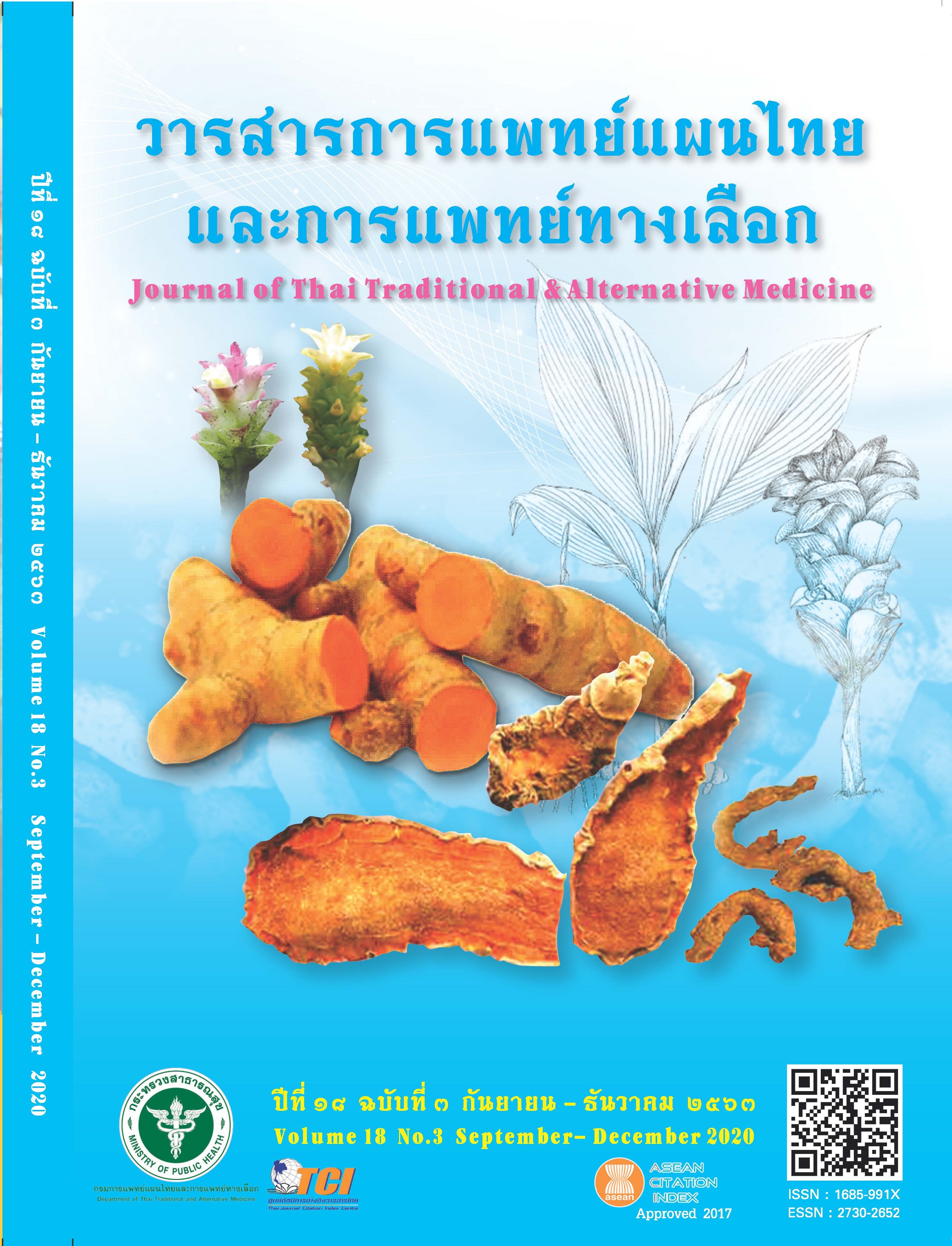ประสิทธิผลของรูปแบบการดูแลรักษาผู้ป่วยมะเร็งระยะสุดท้ายด้วยการแพทย์แผนไทยในโรงพยาบาลการแพทย์แผนไทย
Main Article Content
บทคัดย่อ
การวิจัยกึ่งทดลองแบบกลุ่มเดียวประเมินก่อนและหลังครั้งนี้มีวัตถุประสงค์เพื่อศึกษาประสิทธิผลของรูปแบบการดูแลรักษาผู้ป่วยมะเร็งระยะสุดท้ายด้วยการแพทย์แผนไทยเพื่อนำไปใช้ในโรงพยาบาลการแพทย์แผนไทย โดยทำการศึกษาในโรงพยาบาลการแพทย์แผนไทย 5 แห่ง ได้แก่ 1) โรงพยาบาลการแพทย์แผนไทยและการแพทย์ผสมผสาน 2) โรงพยาบาลอู่ทอง 3) โรงพยาบาลวัฒนานคร 4) โรงพยาบาลขุนหาญและ 5) โรงพยาบาลสมเด็จพระยุพราชสว่างแดนดิน ตั้งแต่เดือน พฤษภาคม–สิงหาคม 2561 คัดเลือกกลุ่มตัวอย่างแบบเจาะจงตามคุณสมบัติที่กำหนด จำนวน 3 กลุ่ม กลุ่มที่ 1 ทีมสหวิชาชีพ จำนวน 55 คน กลุ่มที่ 2 ผู้ป่วยมะเร็งระยะสุดท้ายจำนวน 30 คนและกลุ่มที่ 3 ผู้ดูแลหลักจำนวน 30 คน เครื่องมือที่ใช้ในการเก็บรวบรวมข้อมูล ได้แก่ แบบประเมินความเป็นไปได้ในการนำรูปแบบการดูแลรักษาไปใช้ของทีมสหวิชาชีพ แบบประเมินความทุกข์ทรมานจากอาการ แบบสอบถามความพึงพอใจของทีมสหวิชาชีพผู้ใช้รูปแบบ แบบสอบถามความพึงพอใจของผู้ป่วยและผู้ดูแลผู้ป่วยมะเร็งระยะสุดท้าย การวิเคราะห์ข้อมูลโดยใช้สถิติเชิงพรรณนา และเปรียบเทียบคะแนนประเมินความทุกข์ทรมานจากอาการและผลลัพธ์การดูแล ด้วยการวิเคราะห์สถิติรายคู่ paired t–test ผลการวิจัยพบว่า ประสิทธิผลของรูปแบบการดูแลรักษาผู้ป่วยมะเร็งระยะสุดท้ายด้วยการแพทย์แผนไทยในโรงพยาบาลการแพทย์แผนไทย ทีมสหวิชาชีพประเมินความเป็นไปได้ของการนำรูปแบบไปใช้ว่ามีความเป็นไปได้มาก และรูปแบบการดูแลรักษาสามารถแก้ปัญหาและเกิดผลดีต่อผู้รับบริการมีระดับค่าเฉลี่ยความเป็นไปได้มากที่สุด รวมทั้งมีความพึงพอใจต่อระบบการดูแลรักษาผู้ป่วยมะเร็งระยะสุดท้ายด้วยการแพทย์แผนไทย หลังการพัฒนาระบบสูงกว่าก่อนพัฒนาระบบอย่างมีนัยสำคัญทางสถิติที่ระดับ 0.05 รวมทั้งผู้ป่วยและผู้ดูแลหลักมีความพึงพอใจในระดับมากที่สุด ค่าเฉลี่ยเท่ากับ X̅ = 4.38, S.D. = 0.46 และ X̅ = 4.22, S.D. = 0.38 ตามลำดับ และทีมสหวิชาชีพมีความพึงพอใจในระดับมากค่าเฉลี่ยเท่ากับ X̅ = 4.12, S.D. = 0.18 ผลการศึกษาครั้งนี้แสดงให้เห็นว่า รูปแบบที่พัฒนาขึ้นสามารถนำไปใช้ในการดูแลรักษาผู้ป่วยมะเร็งระยะสุดท้ายด้วยการแพทย์แผนไทยได้ อย่างไรก็ตามควรมีการศึกษาติดตามผลลัพธ์ทางคลินิกเพื่อประเมินประสิทธิผลของรูปแบบที่พัฒนาขึ้นต่อไป
Article Details
เอกสารอ้างอิง
Turk DC, Feldman CS. Noninvasive approaches to pain control in terminal illness: the contribution of psychological variables. Hosp J. 1992;8(1-2):1-23.
Phosri T. Palliative care for End-of-Life Patients: from hospital to home setting. [an independent study report
for the master of nursing science in adult nursing]. Khon Kaen: Khon Kaen University; 2007. (in Thai)
Strategy and Planning Division. Public health statistics A.D. 2019. Nontaburi: Ministry of Public Health; 2020.
(in Thai)
Leelananthakit S. Handbook for palliative care. Bangkok: The Agricultural Co-operative Federation Of Thailand., LTD. Institute Of Geriatric Medicine: Department of Medical Services Ministry of Public Health; 2004. (in Thai)
Maneepong S. Developing model for end of life care in critical care medicine enit, medical nursing division.
Srinagarind Hospital. [an independent study report for the master of nursing science in adult nursing]. Khon
Kaen: Khon Kaen University; 2008. (in Thai)
Tongpratheep T. Nurse’s voice in palliative care. Kuakarun Journal of Nursing. 2004;11(2):36-46. (in Thai)
Paisansuthidaj U. Palliative home care in cancer patients; 2549. (in Thai)
Petrakat P, Chantraket R, et al, editors. Situation report of Thai Traditional Medicine Folk Medicine And Alternative Medicine, B.E. 2005 - 2007. Bangkok: Manasfilm; 2007. (in Thai)
Tungsukruthai P, Nootim P, Phukanad P, Sitthikraiphong K, Charoenuch O, Kangkaew K. Situation report of Thai traditional medicine services in public health service centers B.E. 2003-2007. Traditional Medicine Research
Institute Department for Development of Thai Traditional and Alternative Medicine; 2008. (in Thai)
Shiengthong A, Rakkwamsuk P, Kerdtho S. Result of the study Thai traditional medicine hospital of Department for Development of Thai Traditional and Alternative Medicine. Bangkok. The Institute of Thai Traditional Medicine Department for Development of Thai Traditional
and Alternative Medicine. Bangkok: WVO officer of printing mill; 2015. (in Thai)
Shiengthong A, Sawatrangkun N, Kerdtho S. Clinical practice guidelines for Thai traditional medicine for the
Pilot Hospital of Thai Traditional Medicine. The Institute of Thai Traditional Medicine Department for Development of Thai Traditional and Alternative Medicine. Bangkok: Samcharoen Panich (Bangkok) Co., Ltd; 2016. (in Thai)
Health Care District Support Subdivision Technical and Planning Division Department of Thai Traditional and
Alternative Medicine. Supervision report and propulsion in Thai traditional and alternative medicine Department
of Thai Traditional and Alternative Medicine; 2017. (in Thai)
Khamsaen B. Participation of multidisciplinary teams on primary care in Tambon health promoting hospital
[an independent study report for master of social work program]. Pathum Thani: Thammasat University; 2011.
(in Thai)
Sargeant. Effective interprofessional teams: “Contact not enough” to build a team. JCEHP. 2008;28(4):228-34.
Pilaikiat R, Rittharomya J, Bootchan T. Spiritual care for chronic illness patients: experiences of professional
nurses. Thai Journal of Nursing Council. 2009;24(1):62-76. (in Thai)
Sundstrom E, DeMeuse KP, Futrell D. Work teams: applications and effectiveness. American Psychologist.
;45:120-33.
Vincent II JW (JACK). Community development practice. In: Phillips R, Pittman RH, editors. An introduction to
community development. New York: Route ledge Publisher; 2009.
Sriphattharaphinyo J. Effects of teaching and skill training for caregivers of cerebrovascular patients on
caregivers’ caring ability and patients’ health status. Nakhon Pathom: Mahidol University; 1997. (in Thai)


